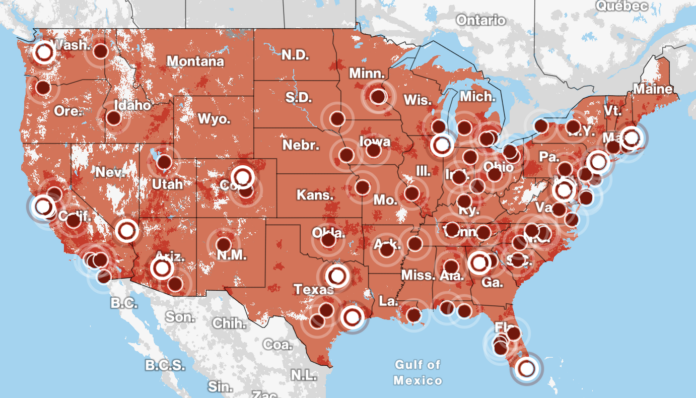Verizon has partnered with AWS and Microsoft on delivering MEC services
Verizon is all in on both public and private MEC and has a range of partnerships in place with the likes of AWS and Microsoft Azure as well as companies focused on applications. But its MEC infrastructure, live in 13 metro areas in its public form and on customers’ premises for private use, is part of a larger solution set, including its 5G network, both sub-6 GHz and mmWave, its private networks business, IoT devices and platform, and managed services.
Partnerships are key in Verizon’s larger strategy of delivering 5G-enabled enterprise solutions. In an interview ahead of Mobile World Congress Los Angeles, Verizon Business Chief Revenue Officer Sampath Sowmyanarayan said, “5G is all about the ecosystem. You cannot do it yourself. That’s been our focus on anything 5G-related.”
This partner-based approach has accelerated Verizon’s sales cycle, Sowmyanarayan said, explaining that depending on the customer, Verizon may take the lead, AWS may take the lead, etc…”It actually helps because we’re able to get to the right decision makers really fast. We can actually short circuit what would typically be a four- to six-month process.”
Verizon working with Nissan on MEC for road safety
One example of how Verizon is using its MEC capabilities is to deliver near-real-time driver notifications to enhance road safety using sensor data. Working with Nissan North America’s Research and Advanced Engineering team, the companies demonstrated how sensor data from vehicles and surrounding infrastructure can be processed at the edge of Verizon’s wireless network and communicated back to the driver in near real time.
The research was aimed at creating “a multi-viewpoint picture of safety hazards” that might be lurking beyond the vehicle and the driver’s line-of-sight. This was accomplished by testing a variety of vehicle-based and infrastructure-based sensor configurations. Then, sensor data gathered from Nissan vehicles and surrounding infrastructure was processed at the edge of Verizon’s network using the carrier’s 5G Edge with AWS Wavelength. Once processed, insights are communicated back via the cellular network to vehicles in near-real-time, prompting Nissan’s Intelligent Shared World platform to initiate driver notifications.
During the trials, drivers were notified of several different safety scenarios, such as pedestrians entering roadways from behind other cars, or of oncoming vehicles obscured behind larger vehicles.
The private, on-prem MEC solution is being used by logistics and supply chain specialist Ice Mobility for computer vision-assisted product packing. This flavor of MEC combines Verizon’s network with the Microsoft Azure Stack Edge. “Business innovation demands powerful technology solutions and central to this is the intersection between the network and edge” said Yousef Khalidi, corporate vice president Azure for Operators at Microsoft. “Through our partnership with Verizon, we are providing customers with powerful compute and storage service capabilities at the edge of customers’ networks, enabling robust application experiences with increased security.”
Testing Standalone 5G and MEC with IBM
While Verizon’s 5G network is currently in Non-Standalone mode of operation, the carrier will ultimately migrate to Standalone 5G; in terms of combining Standalone 5G and MEC, Verizon is already testing in the lab with IBM with an eye on 5G for Industry 4.0 applications.
This latest development in the IBM and Verizon partnership will allow enterprise customers to use the lab, which provides a pre-commercial, Standalone 5G and MEC environment, to develop and test use cases like robotics, guided vehicles, manufacturing process automation, visual quality inspection and data analytics.
“This lab demonstrates the power of optimizing solutions for a new era of hybrid cloud that leverages the growing relationship between ‘connectivity + compute’ to create new value. The lab will provide hands-on experience for enterprises as they seek ways to leverage the new 5G capabilities – reduced latency, increased bandwidth, network slicing and edge — by trialing new use cases and highly automated deployment and management approaches,” wrote Steve Canepa, global GM & managing director, IBM Communications Sector in a blog post.
In an October earnings call, Verizon CEO Hans Vestberg said MEC will be a part of the company’s long-term growth. “When it comes to edge compute, we are the mobile edge compute leader, both in public and private.” In addition to public and private MEC, Vestberg also linked it to delivering private networks. Of those three big use cases, “All of them are in execution right now,” he said. “We’re working with customers.”
To read more about how mobile edge computing is creating new revenue opportunities for smart manufacturing and other areas, read the report, “Monetizing MEC: What’s the value in the edge?” And check out the companion webinar featuring speakers from Google Cloud, Inseego and VoltDB.

